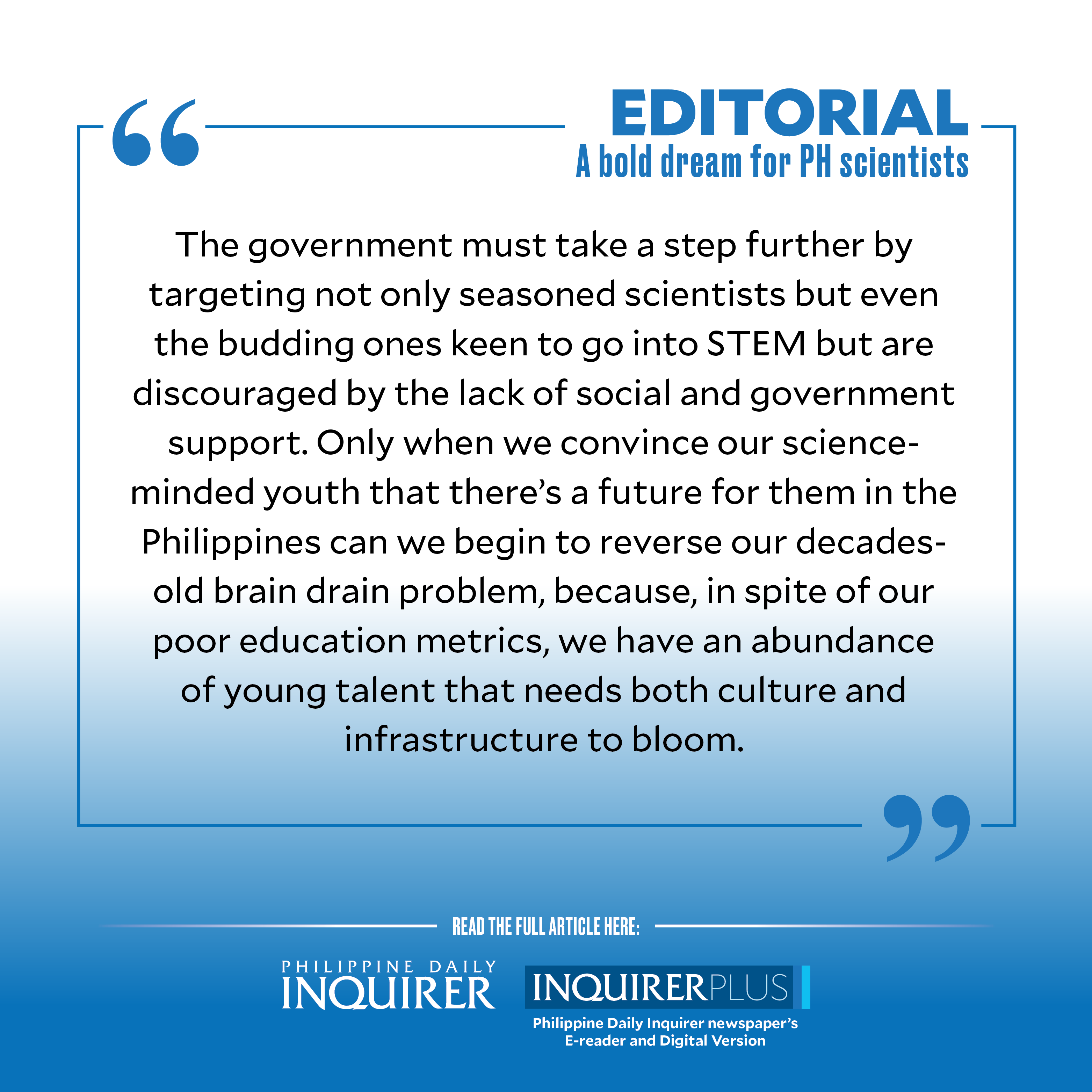A bold dream for PH scientists

Before the advent of the internet, an entire generation of Filipinos was once taught that our kababayan Agapito Flores invented the fluorescent lamp.
This is a myth, of course, and the real credit belongs to the scientists who built the prototype introduced by General Electric in the 1930s. It’s only by the clarity of hindsight that we now recognize the absurdity of that claim. But who could blame us for being gullible? The idea that “fluorescent” originated from “Flores” had seemed so plausible then—it was even written in some textbooks.
Article continues after this advertisementBut those were simpler times when a storybook delusion could morph into popular legend in the absence of fact-checking tools. These days, it won’t be as easy to convince the public that a Filipino could achieve such a feat or be more ambitious to sell the idea that one of us could one day receive the Nobel Prize for the sciences, whose winners were announced this week.
A Filipino Nobel laureate for physics, medicine, or chemistry? Impossible, the naysayers would say, thinking our only chance lies in the literature and peace prizes, the latter already won by journalist Maria Ressa in 2021.
But a nation can dream. As the American scholar John Dewey wrote: “Every great advance in science has issued from a new audacity of imagination.”
Article continues after this advertisementIt might be audacious to envision a Philippines with world-caliber institutions pursuing advances in knowledge, but that is precisely what’s fueling our hopes for the “Balik Scientist Program” (BSP), a Department of Science and Technology (DOST) project to entice Filipino scientists overseas to come home.
Under Republic Act No. 11035, returning scientists enjoy such incentives as round-trip airfare, exemption from travel taxes and import duties, free medical insurance, and relocation benefits like support for job opportunities for their spouses and a housing allowance, among others.
Because of these perks, 44 scientists have returned since last year under the BSP, bringing the total to 631 since 1975, according to DOST. These are modest numbers, but with time, energy, and enough resources, even a tiny ripple can become a big wave.
But true to the scientific method, we must first identify the problems confronting our knowledge sector—which are many—before we can begin to address them.
For instance, in the 2022 Global Innovation Index, the Philippines placed 59th out of 132 countries, sliding down eight spots from 2021. The country listed fewer than 174 full-time researchers per million people, ranking 84th. In contrast, Singapore had 7,287 researchers per million.
The country’s gross expenditure on research and development stands at a mere 0.32 percent, well below the 2-percent global average.
Education in the science, technology, engineering, and mathematics (STEM) field poses a colossal obstacle as well, with the Philippines performing at, or near the bottom, of the 2018 Programme for International Student Assessment, the 2019 Trends in International Mathematics and Science Study, and the 2019 Southeast Asia Primary Learning Metrics.
It may take more than one administration to overcome all these barriers, but we are heartened by the support shown so far by President Marcos, a “frustrated scientist” who has encouraged harnessing science and technology for our national goals, from nuclear power to space development. Beyond platitudes, however, he has also shown readiness to pour funds into these ventures.
In fact, according to Science Secretary Renato Solidum Jr., the BSP budget increased to P79 million this year from P60 million in 2022.
One returnee, marine scientist Dr. Hernando Bacosa, enthused: “We had allowances of about $200 (P11,330) a day, and the government paid for your flights and the host institutions took care of your accommodations.”
This early, our investment is paying off. “Balik Scientists” are making their presence felt in ways big and small in sectors like transportation, energy, and health, according to the Philippine Council for Industry, Energy, and Emerging Technology Research and Development.
But this is far from enough. The government must take a step further by targeting not only seasoned scientists but even the budding ones keen to go into STEM but are discouraged by the lack of social and government support.
Only when we convince our science-minded youth that there’s a future for them in the Philippines can we begin to reverse our decades-old brain drain problem, because, in spite of our poor education metrics, we have an abundance of young talent that needs both culture and infrastructure to bloom.
A people’s capacity to dream, after all, is limited only by their own vision.
Who knows? That future scientist who will someday build the first rocket to fly the Philippine flag in outer space might be living among us already, tinkering with cube satellites in a university lab or toddling up the school steps in a remote village, waiting for the chance to—dare we say it?—shoot for the moon.
















